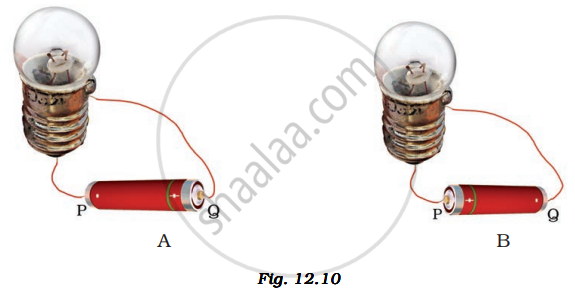Advertisements
Advertisements
Question
Describe the construction, working and usefulness of a dry cell, with the help of a diagram.
Solution
Construction of dry cell
The dry cell consists of the following components:
Outer metal covering: The metal covering is made up of zinc metal and is whitish in appearance. It acts as a negative terminal of the cell.
Electrolyte: Inside the Zinc metal, there is the electrolyte filled between two layers. Electrolyte is a wet pulp of Zinc chloride (ZnCl2) and Ammonium chloride (NH4Cl). It is the charge carrier of electricity as it contains negatively charged and positively charged ions.
Metal rod: There is a graphite rod at the centre of the cell. It is surrounded by a paste of Manganese dioxide (MnO2). It acts as the positive terminal of the cell.

Working of dry cell: Chemical reactions take place between the electrolyte, zinc container and graphite rod. Because of this, electric charge is produced on the two terminals of the cell and electric current flows in the circuit.
Usefulness of dry cell: They are handy and portable. The life of the dry cell is longer than cells using liquid electrolyte. Dry cells can be used in the torch, T.V. or A.C remote controls, toys, etc.
RELATED QUESTIONS
State two precautions that you must take when switching on an electric circuit.
Explain the construction and working of a dry cell.
Which one of the following is using secondary using cells?
A chemical solution that produces positive and negative ions is used as ______.
A battery is a group of ______.
Define electric cell. What is the direction of the electric current in a cell?
A torch requires 3 cells. Show the arrangement of the cells, with a diagram, inside the torch so that the bulb glows.
When the chemicals in the electric cell are used up, the electric cell stops producing electricity. The electric cell is then replaced with a new one. In case of rechargeable batteries (such as the type used in mobile phones, camera and inverters), they are used again and again. How?
Paheli wanted to glow a torch bulb using a cell. She could not get connecting wires, instead, she got two strips of aluminium foil. Will she succeed? Explain, how?
Fig. 12.10 A and B, show a bulb connected to a cell in two different ways.

Will the bulb glow in both the cases?
